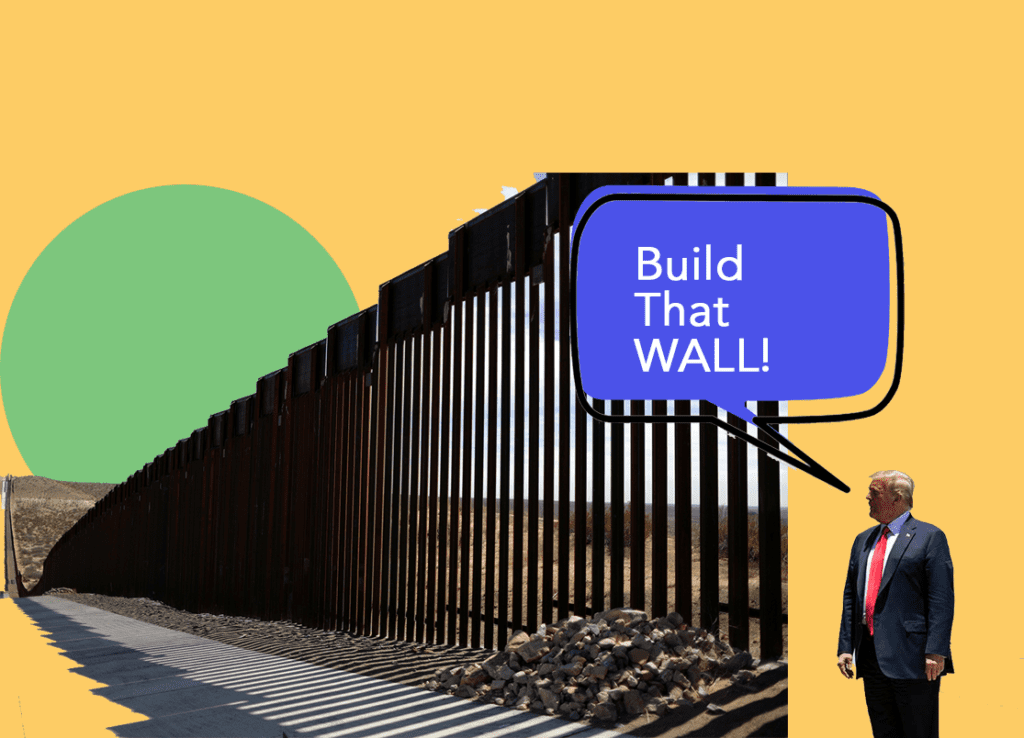“We build too many walls and not enough bridges.’ – Sir Isaac Newton
The pantheon of revolution and associated revolutionaries remains a familiar one. What history book could ignore Russia 1917, China 1949 or Cuba 1959? Today, political revolution inspires the nostalgia of lost idealism among an ever-diminishing band of believers. In 2022 the revolutionaries are in science and technology, more Elon Musk than Che Guevara.

Ronald ‘Revolution’ Reagan
We instinctively look to the charismatically bearded left of politics when we think of revolution; in doing so we turn our back on one of the great revolutionaries of the twentieth century. Ronald Reagan is usually labeled as a ‘conservative’, but his iconic Cold War intervention in 1987 was about destruction, not conservation.
In 1987 President Reagan visited West Berlin and called on Soviet Premier Gorbachev to,
“Tear down this wall.”

In 1989 Hungary opened its border with Austria and East Germans used the opening to flee into West Germany. Four other fortified borders were opened soon after; those between Czechoslovakia and West Germany, USSR and Finland, USSR and Norway and the Berlin Wall.
The end of the Cold War permitted the European Union (EU) to spread eastwards. The end of isolationist communism saw the former USSR, China, and Vietnam integrated into the global economic system during the 1990s. These trends was superimposed upon a global tendency of liberalizing international trade and investment reforms across Africa, Asia, Latin America, and elsewhere that had begun in the 1980s. The era of globalization saw a surge in cross-border flows of trade, foreign investment, migration of people, patterns of consumerism, and cultural tastes.

Walls and Urbanization or Urbanization = Walls?
The Berlin Wall was not the temporary aberration of a failed political system (communism) whose destruction returned the world back to ‘normal’. The call by Ronald Reagan to tear down walls represented a truly revolutionary act. Revolutionary because, since humans first moved into urban areas, walls have been a characteristic feature of cities.
By 3000 BCE the Sumerian city of Uruk (modern Iraq) and its population of 80,000 were protected by a 6-mile-long wall. The ancient civilizations of Assyria, Israel and Sumer have been described as “clusters of birdcages” with every city being a walled oasis of relative safety and travel between them being perilous.
The walls of fifth century BCE Athens secured Athenian access to the Aegean Sea and long protected the city from land-based military threats. By promoting openness to trade and freedom from reliance on a standing army, Athens flourished as a cultural, democratic (for the citizens, not slaves), architectural, literary, philosophical, and mathematical haven.
Nebuchadnezzar II of Babylon (605-562 BCE) was the first ruler to establish a defensive perimeter around an entire country. Walls then went further and evolved into something that spanned entire civilizations. A Great Age of Wall building in the first five centuries CE fostered the development of three vast regions: China, the Islamic World, and the West.
Between 83-260 CE, the Roman Empire turned from expansion to consolidation and built walls along the edges of its established empire, including the 118 km Hadrian’s Wall and 60 km Antonine Wall in modern Scotland, a 750 km wall in North Africa, and the 568 km Germanicus wall in Germany. In 430- 570 CE, the Sassanid Empire (modern-day Iran) built walls to protect its borders from nomadic neighbors. The most important of these walls was the 200 km Gorgan Wall that featured 38 forts, a network of canals (for water and defense) and a garrison of at least 20,000 troops. In 585 CE, China Emperor Wen put 30,000 workers to wall building, increasing this to 150,000 in the next year. By 607 CE, one million men were laboring to build the Yang Walls and scholars have estimated that 500,000 died in their construction.
In the fifth century Alaric pillaged Rome, Hadrian’s Wall fell into disrepair, and Western Europe abandoned their cities and villas and retreated into hill forts—the Dark Ages. The Sassanids had constructed walls that faced north to protect their sophisticated urban culture from the nomadic steppe people. The Sassanid Empire instead fell to an Islamic Arab invasion from the south. China’s walled civilization was the only one of the three to survive. Walls were not exclusive to Eurasia. Around 800 CE Benin-city in West Africa was possibly the world’s largest planned urban entity. Benin-City comprised a network of 16,000 km of walls that enclosed an entire kingdom comprised of hundreds of interlocked cities and villages. The walls of Benin were destroyed by Europeans during the late Victorian colonial era.

A New Age of Walls
The Reagan-ite call to pull down walls rebelled against a human instinct that has ever been synonymous with urbanization. The Reagan Revolution was a blip. Walls never went away. The twenty-first century has seen a renaissance of wall building.
The so-called ‘Trump Wall’ with Mexico has been portrayed as a uniquely American aberration and a product of the partisan symbol of US cultural division. In fact, much of the ‘Trump Wall’ was constructed by Bill Clinton under Operations Blockade and Hold the Line. Both Hillary Clinton and Barack Obama voted for President Bush’s 2006 Secure Fences Act which extended the wall hundreds of miles. Border wall construction continued during the Obama presidency. By 2009 the US had walled more than 700-miles of its borders. The Trump Wall is a product of bipartisan consensus not political conflict.

After the fall of the Berlin Wall Europe soon resumed wall building and now has a similar number of walled borders as during the Cold War. Among the many newly walled borders include Greece and Turkey, Bulgaria and Turkey, Turkey and Syria, Hungary and Serbia, Greece and Macedonia, Macedonia and Serbia, Serbia and Hungary, Slovenia and Croatia. Outside Europe after a spate of suicide bombings, Israel began construction of a 450-mile wall (though only 3% of the length is concrete) with Palestine. Egypt contributed a steel wall between itself and Palestine that extends 60 feet underground to prevent tunneling. Between 2002 and 2010, 15 new security walls and fences were built in the Middle East as the Islamic State (ISIS) insurgency, terrorism, and illegal migration threatened ruling regimes in the region. In Saudi Arabia construction began in 2003 of a 1,100 mile 10 feet high concrete and barbed wire border with Yemen and a 600-mile wall with Iraq. Saudi Arabia is now nearly completely enclosed. Jordan and Syria are divided by one of the world’s (US-funded) most high-tech fences replete with sensors and night-vision cameras. Across the cities of Baghdad, Damascus, Amman, Beirut, Cairo, and Riyadh walls are common around embassies, police stations, army barracks, and government buildings. The Middle East has been reasonably referred to as “a honeycomb of fences and walls”. In Asia walls have sprouted between Uzbekistan and its five neighbors, Brunei and Malaysia, India and Bangladesh, Malaysia and Thailand, China and North Korea and of course South Korea and North Korea. In Africa South Africa has been constructing a lethal electrified fence on its border with neighbors Mozambique and Zimbabwe since 1986.
Walls and the Final Age of Urbanization
In 1950, 30% of the world’s population (746 million people) were urban, in 2014 this had risen to 54% (3.9 billion). By 2100, the UN predicts the urban population share will reach and stabilize at around 75%. In the 40 years to 2050 this entails an increase of 2.6 billion urban residents. The media image of urbanization is often that of slum-growth in existing mega-cities. Urbanization today is also closely associated with the growth of newly built cities. The long-established pioneer of new city building is China, where 600 new cities have been built since 1949. This momentum has spread worldwide. Since the early 2000s construction has started on hundreds of new cities across Africa and Asia. Indonesia is building 27 new cities. Over a dozen countries in Africa are building more than 70 new cities.
Many argue that this final phase of human urbanization will be synonymous with walls – or gated communities as they are often called. The rise of gated communities is commonly seen to be driven by the global shift towards privatization and reliance on markets. Gated communities appeal to an ethos that emphasizes individualism and offering consumers more choice. This retreat from the public realm has been described as the affluent exercising a consumer choice and seeking privacy, safety and greater social segregation. In Asia the upper classes have turned to gated communities to ensure better access to high-quality infrastructure and private social and domestic services. The rise of private enclaves has also been likened as a “secession” by an elite opposed to welfare and redistribution.

Tearing Down Walls in 2022 and Charter Cities
A charter city is a newly built, greenfield city that is defined in terms of its ‘special jurisdiction’, whereby the new city government is delegated authority by a host country to write new laws of city governance. Being greenfield no-one will be rendered an involuntary migrant as they see their existing city and home turned into a charter city against their wishes. A new city can’t simply be a gated community for the wealthy. A new city needs to be built and so to employ legions of workers in construction. A new city needs to be operated and run by all those blue-collar jobs which offer an escape from poverty for the poorest, drivers, cleaners, security guards, factory workers, and retail workers. A charter city would need the schools, hospitals and professional services that could employ the better-educated children of first-generation migrant factory workers. A charter city would encompass both the narrowing vision of contemporary globalization, of culture and investment but also return us to the ideals of Reagan’s revolutionary vision. To survive and prosper a charter city would need migrants, both local and international. A charter city would be founded on a principle of migration.
Charter cities are not about charitable aid for migrants but founded on the lure of the largest untapped potential gains from globalization.
One study estimates that allowing workers to seek the highest wages and firms to seek the most productive workers at a global level will boost global GDP between 50 and 100%. This is compared to a few percent of GDP from eliminating remaining policy barriers on trade and capital flows. Even this massive number is likely to be an under-estimate. The component parts of globalization tend to reinforce each other. More migration, for example, stimulates foreign investment and trade. The fall of the Berlin Wall and the related upsurge in east-west migration had a positive and significant impact on west-east investment flows.
Ronald Reagan may have been a revolutionary when he saw walls, but he was a conservative when he saw the need for firms to make profits.
He was a revolutionary, but just not of the bearded variety.







